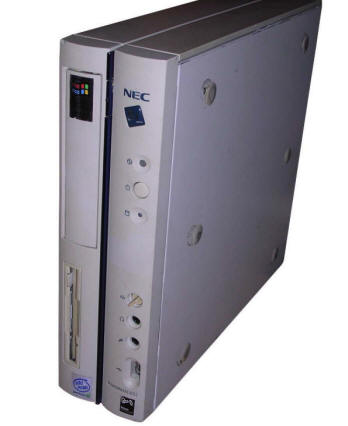Nec PowerMate ES Slimline
In 2000, Japanese corporation Nec released this member
of PowerMate computers line. It is a very small PC, which can stand as
tower, lay as desktop or, with help of special handles, be fixed under a
desk. It was shipped in different configurations around VIA, Celeron and
Pentium III processors. Most components are on-board, giving 3 PCI slots
for expansion.
Because these computers were small and their power consumption was not
high, they were used in 2000s as office computers.
| Manufacturer | Nec | |
| Origin | Japan | |
| Year of unit | 2000 | |
| Year of introduction | 2000 | |
| Class | XATX | |
| CPU | Intel Pentium III | |
| Speed | 800MHz | |
| RAM | 256MB (2x128MB PC100 DIMM) |
|
| ROM | PC BIOS | |
| Graphics | Onboard Intel (VRAM shared) |
|
| Sound | Onboard Intel AC97 | |
| System expansion bus | PCI (3 slots on riser) |
|
| Floppy/removable media drives | 1x 3.5" 1.44MB floppy drive, slimline | |
| Hard disk: |
Seagate ST320420A (20GB, PATA) |
|
|
Peripherals in collection: |
||
| Other boards:
|
Onboard 3Com network adapter Onboard 2xCOM/LPT/USB controllers. |
|
| Non-standard expansions: | - | |
| Operating system(s): | Windows 98 |
My unit has been bought from reseller which purchased Necs on electronic waste from USA, exactly from Montgomery County offices as some inventory stickers form it are still present. Unfortunately it was in bad physical condition, CD drive door has been damaged and capacitors were bad. Machine has been restored.
| Contents: | Starting, usage | Problems | Links |
Starting
Computer boots up as typical PC. F2 to get to BIOS. It beeps once and boots to OS.
Inside case, there is a sticker which shows jumpers for BIOS reset, Intel/Cyrix CPU and sound enable/disable.
The machine is prone to two problems: Capacitor plague and overheating.
Problems with capacitors are usually seen near CPU,
where "Chhsi" defective capacitors have been used. They should be
changed or machine will be unstable and will overheat more than usually.
If you hear random beeps during operation, it means that CPU
voltage is swinging and capacitors should be replaced.
Another problem is overheating. The computer may have
two mainboards: One with built-in VIA CPU, the other one with Socket
370. Both tend to overheat. If you plan to add something better than
500MHz Celeron, use a good, large heatsink and fan, The fan won't do
much, as it is covered by floppy drive (sometimes it may be needed to
remove/flatten/cut metal protrusion from the bttom of FDD chassis) but
is needed to make machine operate without larger overheating. Try before
you install as floppy drive is limiting the height of CPU cooler.
Floppy drive ribbon cable blocks air flow between CPU and power supply
unit, so sometimes it may be better to put it higher, above the air duct
between power supply and CPU heatsink. However in this configuration
some PCI boards may not fit.
Power supply is very densely populated, in small volume
there are a few PCBs. In normal operation, air is pulled from the bottom
vent holes, passes near RAM, CPU cooler, mainboard and is pushed through
power supply unit outside. The problem is that dust is filtered on power
supply components.
I found that in normal operation air exhausted form power supply is
quite warm. If is is not going out as well as it should, power supply
unit should be carefully removed and cleaned. If not, the machine will
overheat.
You may encounter a third problem with Windows 2000 - after installing the lastst patches it may refuse to boot with blue screen. I haven't found a workaround, however some users reported that reinstalling drivers helped.
If you have such computer, remember that its mechanical parts are fragile. It is very easy to damage CD-ROM drive door, and during closing cover volume trimmer knob should be maintained all time to prevent tearing trimmer from PCB.
https://support.necam.com/Legacy/Desktops/es/ - They still offer
manuals and drivers for Win98 to download! Windows 2000 and later have
all drivers.
http://www.pcmag.com/article2/0,2817,13811,00.asp - Review





